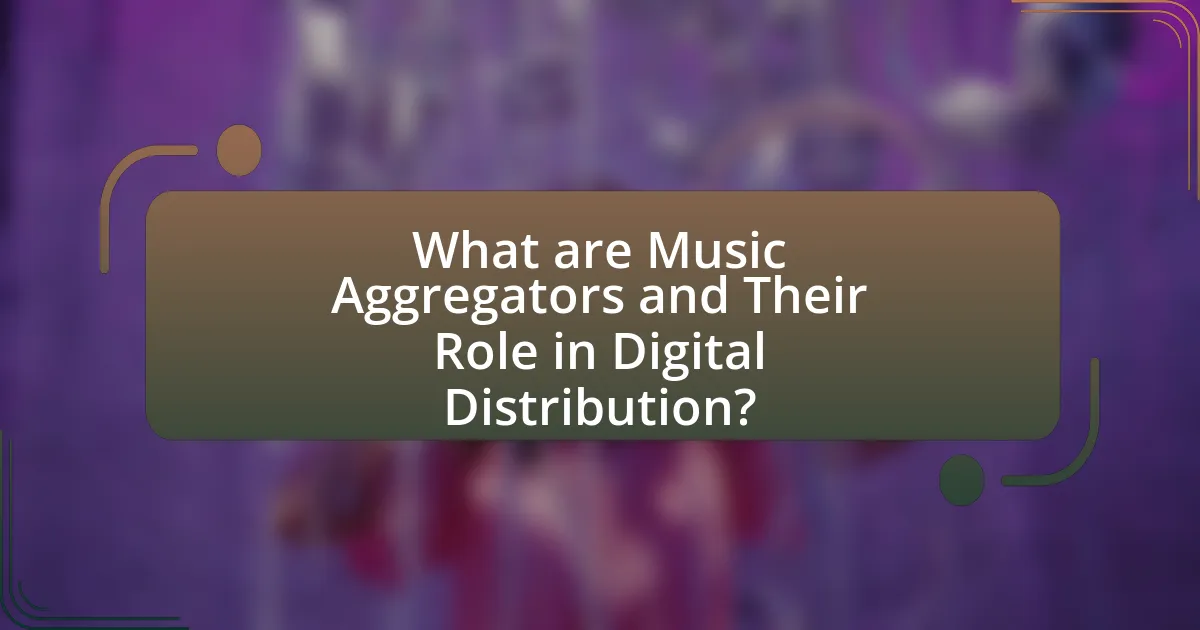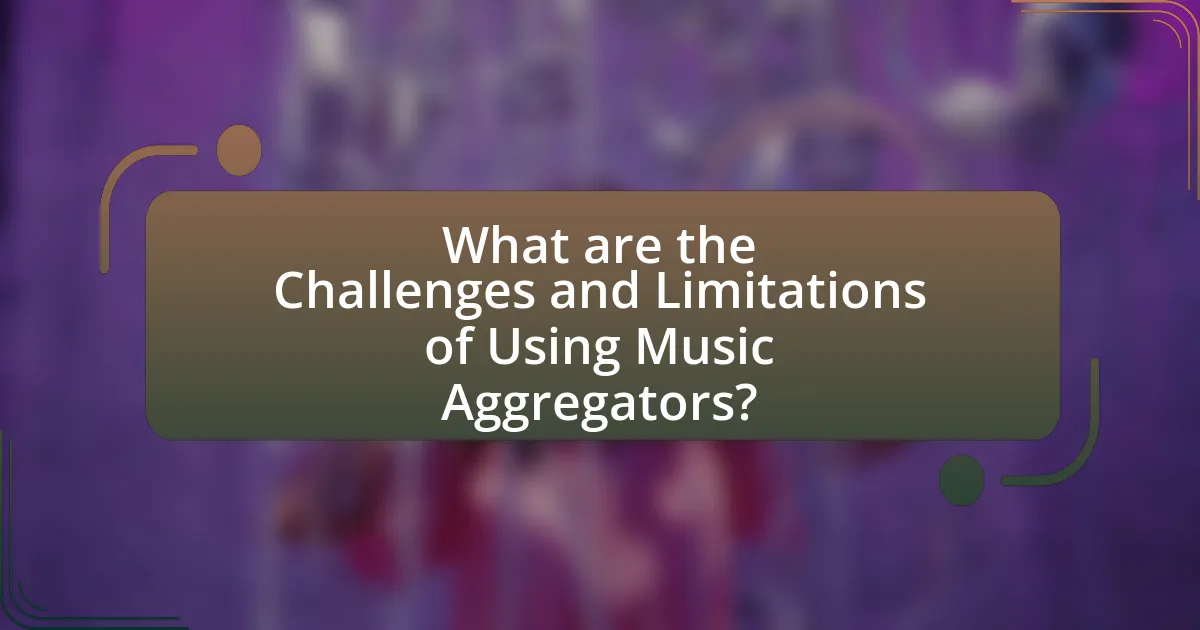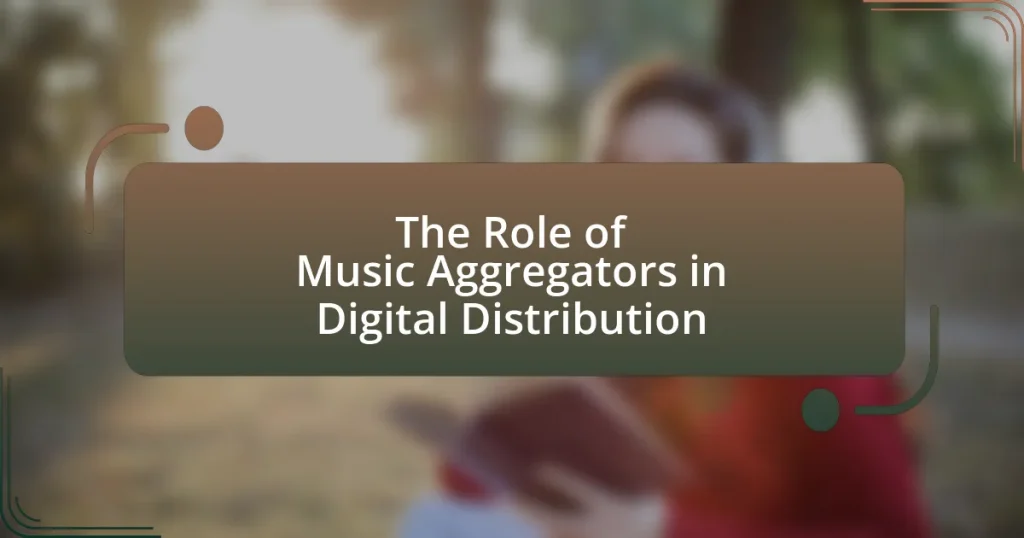Music aggregators are companies that facilitate the distribution of music from independent artists and labels to various digital platforms, such as Spotify, Apple Music, and Amazon Music. They serve as intermediaries, simplifying the digital distribution process by allowing artists to upload their music to multiple services simultaneously while managing essential tasks like royalty collection and metadata management. The article explores the functions of music aggregators, their significance for independent artists, the challenges faced without them, and the advantages they offer over traditional record labels. Additionally, it discusses the key features of aggregators, the impact of technology on their evolution, and emerging platforms that influence their role in the digital music ecosystem.

What are Music Aggregators and Their Role in Digital Distribution?
Music aggregators are companies that facilitate the distribution of music from artists to various digital platforms, such as Spotify, Apple Music, and Amazon Music. They serve as intermediaries, allowing independent musicians and labels to upload their music to multiple streaming services without needing to establish individual relationships with each platform. This process simplifies digital distribution, enabling artists to reach a wider audience efficiently. According to a report by MIDiA Research, music aggregators account for a significant portion of digital music distribution, with many independent artists relying on them to navigate the complexities of the digital landscape.
How do Music Aggregators function in the digital music ecosystem?
Music aggregators function as intermediaries that distribute music from artists to various digital platforms, such as Spotify, Apple Music, and Amazon Music. They streamline the process by allowing independent musicians to upload their tracks to a single service, which then distributes the music across multiple platforms, ensuring wider reach and accessibility.
Aggregators also handle essential tasks such as royalty collection, metadata management, and copyright protection, which are crucial for artists to receive fair compensation for their work. For instance, services like DistroKid and TuneCore enable artists to retain a larger percentage of their earnings compared to traditional record labels, thereby empowering musicians in the digital landscape.
The effectiveness of music aggregators is evidenced by the growth of independent artists in the music industry; according to the IFPI Global Music Report 2021, independent music accounted for 40% of global recorded music revenue, highlighting the significant role aggregators play in facilitating this success.
What services do Music Aggregators provide to artists and labels?
Music aggregators provide essential services to artists and labels by facilitating the distribution of music to various digital platforms. These services include digital distribution to streaming services like Spotify and Apple Music, ensuring that artists’ music reaches a wide audience. Additionally, music aggregators offer royalty collection, which involves gathering and distributing earnings from streams and downloads to the artists and labels. They also provide tools for marketing and promotion, enabling artists to enhance their visibility in a competitive market. Furthermore, many aggregators offer analytics and reporting services, allowing artists and labels to track performance metrics and understand their audience better. This comprehensive support system is crucial for artists and labels navigating the complexities of digital music distribution.
How do Music Aggregators connect artists with digital platforms?
Music aggregators connect artists with digital platforms by acting as intermediaries that facilitate the distribution of music to various streaming services and online stores. They streamline the process by providing artists with a single point of access to multiple platforms, such as Spotify, Apple Music, and Amazon Music, allowing for efficient upload and management of their music catalog. Aggregators often handle the technical requirements, metadata submission, and royalty collection, ensuring that artists receive their earnings from streams and downloads. This model is supported by the fact that, according to a report by MIDiA Research, over 60% of independent artists use aggregators to distribute their music, highlighting their essential role in the digital music ecosystem.
Why are Music Aggregators essential for independent artists?
Music aggregators are essential for independent artists because they facilitate the distribution of music across multiple digital platforms, ensuring wider reach and accessibility. By using aggregators, independent artists can upload their music to major streaming services like Spotify, Apple Music, and Amazon Music without needing direct contracts with each platform. This streamlined process not only saves time but also allows artists to focus on their creative work while maximizing their potential audience. Furthermore, music aggregators often provide valuable analytics and reporting tools, enabling artists to track their performance and make informed decisions about their marketing strategies.
What challenges do independent artists face without Music Aggregators?
Independent artists face significant challenges without music aggregators, primarily in distribution, visibility, and revenue generation. Without aggregators, artists struggle to distribute their music across major streaming platforms like Spotify and Apple Music, limiting their audience reach. This lack of access to widespread distribution channels results in reduced visibility, making it difficult for independent artists to gain traction in a competitive market where over 60,000 new tracks are released daily. Additionally, without the support of aggregators, artists often miss out on essential marketing tools and analytics that help optimize their promotional strategies, further hindering their ability to generate revenue. The absence of these resources can lead to lower streaming numbers and diminished financial returns, ultimately impacting the sustainability of their music careers.
How do Music Aggregators help in reaching a wider audience?
Music aggregators help artists reach a wider audience by distributing their music across multiple streaming platforms and digital stores simultaneously. This broad distribution increases visibility, as artists can be featured on popular services like Spotify, Apple Music, and Amazon Music, which collectively have millions of users. For instance, according to a report by the International Federation of the Phonographic Industry (IFPI), over 400 million people globally use paid music streaming services, highlighting the potential audience available through these platforms. By utilizing music aggregators, artists can tap into this extensive market, enhancing their chances of gaining new listeners and increasing their overall reach.

What are the Key Features of Music Aggregators?
Music aggregators provide essential services for independent artists and labels by distributing music to various streaming platforms. Key features include digital distribution, which allows artists to upload their music to multiple platforms like Spotify, Apple Music, and Amazon Music simultaneously. Additionally, music aggregators offer royalty collection services, ensuring that artists receive payments from streaming services based on their plays. They also provide analytics and reporting tools, enabling artists to track their performance and audience engagement across different platforms. Furthermore, many aggregators offer marketing support, helping artists promote their music through playlists and social media. These features collectively enhance the visibility and revenue potential for artists in the digital music landscape.
What types of distribution services do Music Aggregators offer?
Music aggregators offer various distribution services, including digital distribution to streaming platforms, online music stores, and social media channels. These services enable artists to release their music on platforms like Spotify, Apple Music, and Amazon Music, ensuring wide accessibility. Additionally, music aggregators often provide royalty collection services, allowing artists to receive payments from multiple sources efficiently. They may also offer promotional tools, analytics, and support for copyright registration, enhancing the overall distribution process for independent musicians.
How do Music Aggregators handle royalty collection and payments?
Music aggregators manage royalty collection and payments by acting as intermediaries between artists and digital platforms. They collect royalties from various streaming services and digital retailers, ensuring that artists receive their earnings based on the number of streams or downloads. Aggregators typically have agreements with these platforms that outline the percentage of revenue they retain for their services, which can range from 10% to 30%.
Once royalties are collected, music aggregators distribute payments to artists, often on a monthly or quarterly basis, after deducting their fees. They provide detailed statements that break down earnings by platform, allowing artists to track their revenue sources. This process is supported by technology that automates data collection and payment distribution, ensuring accuracy and efficiency in royalty management.
What promotional tools do Music Aggregators provide for artists?
Music aggregators provide artists with various promotional tools, including playlist placements, social media marketing, and analytics reporting. Playlist placements allow artists to gain exposure by being featured on popular streaming playlists, which can significantly increase their listener base. Social media marketing tools enable artists to promote their music directly to fans and potential listeners through targeted advertising campaigns. Analytics reporting offers insights into listener demographics and engagement, helping artists tailor their promotional strategies effectively. These tools collectively enhance an artist’s visibility and market reach in the competitive digital music landscape.
How do Music Aggregators differ from traditional record labels?
Music aggregators differ from traditional record labels primarily in their business model and the services they provide to artists. While traditional record labels typically sign artists to contracts, offering advances and taking a significant percentage of revenue, music aggregators operate on a fee-based model, allowing artists to retain full ownership of their music and a larger share of their earnings. For instance, platforms like DistroKid and TuneCore charge a flat fee for distribution services, enabling artists to distribute their music across multiple streaming platforms without relinquishing rights. This model reflects a shift towards empowering independent artists in the digital landscape, as evidenced by the rise of self-released music, which accounted for over 40% of global music revenue in 2020, according to the International Federation of the Phonographic Industry (IFPI).
What advantages do Music Aggregators offer over traditional distribution methods?
Music aggregators provide several advantages over traditional distribution methods, primarily through streamlined access to multiple platforms and enhanced revenue opportunities. Unlike traditional methods that often require complex contracts and negotiations with individual distributors, music aggregators allow artists to distribute their music to numerous streaming services and digital stores simultaneously, simplifying the process. Additionally, aggregators typically offer better revenue splits, with many providing artists with a higher percentage of sales compared to traditional labels, which often take a significant cut. For instance, platforms like DistroKid and TuneCore allow artists to retain up to 100% of their earnings, whereas traditional labels may retain 50% or more. This model not only increases the potential earnings for artists but also democratizes access to distribution, enabling independent musicians to reach global audiences without the barriers imposed by traditional industry gatekeepers.
How do revenue models compare between Music Aggregators and record labels?
Music aggregators and record labels have distinct revenue models. Music aggregators typically earn revenue through a percentage of digital sales and streaming royalties, often charging artists a flat fee or a commission for distribution services. In contrast, record labels generate income through a combination of album sales, licensing deals, and artist royalties, often investing in marketing and production costs upfront. For example, while aggregators may take around 15-30% of streaming revenue, record labels might retain 50-70% of an artist’s earnings after recouping their initial investment. This fundamental difference highlights how aggregators focus on distribution efficiency, while record labels emphasize broader artist development and marketing strategies.

What are the Challenges and Limitations of Using Music Aggregators?
The challenges and limitations of using music aggregators include high fees, lack of control over distribution, and potential delays in revenue payments. Music aggregators typically charge a percentage of sales or a flat fee, which can significantly reduce an artist’s earnings. Additionally, artists often relinquish some control over how and where their music is distributed, which can limit their ability to engage directly with fans. Furthermore, revenue payments from aggregators can be delayed, sometimes taking months to process, which affects cash flow for independent artists. These factors collectively pose significant hurdles for musicians relying on aggregators for digital distribution.
What common issues do artists encounter with Music Aggregators?
Artists commonly encounter issues with music aggregators related to delayed payments, lack of transparency, and limited customer support. Delayed payments can occur due to lengthy processing times, which can hinder an artist’s cash flow. Lack of transparency often manifests in unclear reporting on streams and sales, making it difficult for artists to understand their earnings. Additionally, limited customer support can leave artists without assistance when they face technical issues or have questions about their distribution. These challenges can significantly impact an artist’s experience and financial stability in the digital music landscape.
How can artists navigate the complexities of aggregator contracts?
Artists can navigate the complexities of aggregator contracts by thoroughly reviewing the terms and seeking legal advice when necessary. Understanding key elements such as revenue splits, distribution rights, and termination clauses is essential for artists to protect their interests. For instance, many aggregators offer different pricing models, including flat fees or percentage-based commissions, which can significantly impact an artist’s earnings. Additionally, artists should compare multiple aggregator options to find the best fit for their distribution needs, as each aggregator may have unique terms and conditions. Engaging with industry professionals or legal experts can provide clarity on complex legal jargon and ensure that artists make informed decisions regarding their contracts.
What are the potential pitfalls of relying solely on Music Aggregators?
Relying solely on music aggregators can lead to several potential pitfalls, including limited control over distribution, lack of direct artist-audience engagement, and reduced revenue transparency. Music aggregators often take a percentage of the earnings, which can diminish the overall income for artists. Additionally, artists may find themselves at the mercy of the aggregator’s algorithms and policies, which can affect visibility and reach. Furthermore, the reliance on these platforms can hinder artists from building a loyal fanbase, as direct interactions with listeners are often minimized. These factors collectively highlight the risks associated with depending exclusively on music aggregators for digital distribution.
How can artists maximize their success with Music Aggregators?
Artists can maximize their success with music aggregators by selecting the right aggregator, optimizing their metadata, and actively promoting their music. Choosing an aggregator that aligns with their genre and target audience ensures better placement on streaming platforms. Properly optimizing metadata, including accurate song titles, artist names, and genre tags, enhances discoverability, as platforms like Spotify and Apple Music rely on this information for recommendations. Actively promoting their music through social media, email newsletters, and collaborations increases visibility and engagement, leading to higher streaming numbers and potential revenue. According to a report by MIDiA Research, artists who engage in proactive marketing see a 30% increase in their streaming performance compared to those who do not.
What best practices should artists follow when choosing a Music Aggregator?
Artists should prioritize transparency, distribution reach, and pricing when choosing a music aggregator. Transparency ensures that artists understand the terms of service, including fees and revenue splits, which can significantly impact their earnings. Distribution reach is crucial as it determines how many platforms and territories the music will be available on; aggregators with extensive networks can maximize exposure. Pricing models should be evaluated to ensure they align with the artist’s budget and expected revenue, as some aggregators charge upfront fees while others take a percentage of sales. Additionally, artists should consider the aggregator’s reputation and customer support, as reliable assistance can be vital in resolving issues that may arise during distribution.
How can artists effectively promote their music through aggregators?
Artists can effectively promote their music through aggregators by utilizing their distribution networks and marketing tools. Aggregators like DistroKid, TuneCore, and CD Baby provide access to major streaming platforms, which increases visibility and reach. By leveraging these platforms, artists can target specific audiences and utilize promotional features such as playlist placements and social media integration.
For instance, according to a report by MIDiA Research, artists who actively engage with playlists see a significant increase in streams, with playlist placements driving up to 30% of total streams for new releases. Additionally, aggregators often offer analytics tools that help artists understand their audience demographics and listening habits, allowing for more tailored marketing strategies.
What are the future trends for Music Aggregators in digital distribution?
Future trends for music aggregators in digital distribution include increased use of artificial intelligence for data analytics, enhanced direct-to-fan sales models, and the integration of blockchain technology for transparent royalty distribution. Music aggregators are leveraging AI to analyze listener behavior and optimize marketing strategies, which can lead to more targeted promotions and increased revenue. Additionally, the rise of platforms that allow artists to sell directly to fans is prompting aggregators to adapt their services to support these models, thereby fostering closer artist-fan relationships. Furthermore, blockchain technology is being explored to ensure fair and transparent royalty payments, addressing long-standing issues of trust and efficiency in the music industry. These trends indicate a shift towards more artist-centric and technologically advanced distribution methods.
How is technology shaping the evolution of Music Aggregators?
Technology is significantly shaping the evolution of music aggregators by enhancing their capabilities in distribution, data analytics, and user engagement. Advanced algorithms and machine learning enable aggregators to optimize music distribution across various platforms, ensuring artists reach wider audiences efficiently. For instance, services like DistroKid and TuneCore utilize technology to streamline the upload process, allowing artists to distribute their music to over 150 platforms globally in a matter of minutes. Additionally, data analytics tools provide insights into listener behavior, helping artists and aggregators make informed decisions about marketing strategies and audience targeting. According to a report by MIDiA Research, the global music streaming market is projected to grow to $23.1 billion by 2023, highlighting the increasing reliance on technology for music distribution and consumption.
What emerging platforms are influencing the role of Music Aggregators?
Emerging platforms such as TikTok, Bandcamp, and Audiomack are significantly influencing the role of music aggregators. TikTok’s viral nature allows independent artists to gain exposure rapidly, prompting aggregators to adapt their services to facilitate music distribution on this platform. Bandcamp empowers artists by providing direct sales and fan engagement tools, leading aggregators to offer more artist-centric features. Audiomack focuses on free streaming and monetization for emerging artists, pushing aggregators to enhance their offerings in terms of analytics and promotional support. These platforms are reshaping how music aggregators operate by prioritizing artist autonomy and leveraging social media dynamics for music promotion.
